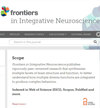投稿信息
稿件收录要求
Frontiers in Integrative Neuroscience publishes rigorously peer-reviewed research that synthesizes multiple facets of brain structure and function, to better understand how multiple diverse functions are integrated to produce complex behaviors.
Indexed in Web of Science (ESCI), Scopus, PubMed and more.
Frontiers in Integrative Neuroscience publishes rigorously peer-reviewed research that synthesizes multiple facets of brain structure and function, to better understand how multiple diverse functions are integrated to produce complex behaviors. Led by an outstanding Editorial Board of international experts, this multidisciplinary open-access journal is at the forefront of disseminating and communicating scientific knowledge and impactful discoveries to researchers, academics, clinicians and the public worldwide.
Our goal is to publish research related to furthering the understanding of the integrative mechanisms underlying brain functioning across one or more interacting levels of neural organization. In most real life experiences, sensory inputs from several modalities converge and interact in a manner that influences perception and actions generating purposeful and social behaviors. The journal is therefore focused on the primary questions of how multiple sensory, cognitive and emotional processes merge to produce coordinated complex behavior. It is questions such as this that cannot be answered at a single level – an ion channel, a neuron or a synapse – that we wish to focus on. In Frontiers in Integrative Neuroscience we welcome in vitro or in vivo investigations across the molecular, cellular, and systems and behavioral level. Research in any species and at any stage of development and aging that are focused at understanding integration mechanisms underlying emergent properties of the brain and behavior are welcome.




